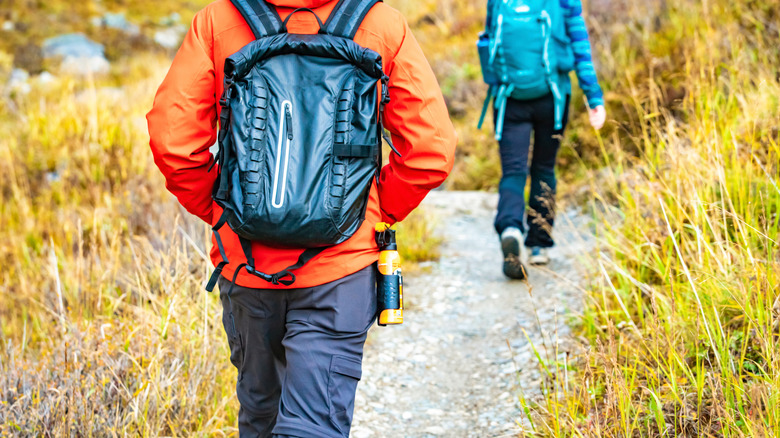The Biggest Differences Between Bear Spray And Pepper Spray
We may receive a commission on purchases made from links.
A canister of bear spray is a crucial emergency item to have on hand when adventuring in bear territory. According to numerous bear experts, bear spray is the best way to stop an aggressively charging bear and prevent a full bore bear attack. In the same vein, self-defense experts have long touted pepper spray, or mace, as the most effective way to fend off an aggressive attacker. This has led many people to believe bear spray and pepper spray are the same. Not exactly.
One reason people believe these two products are interchangeable is because peppers power both bear spray and self-defense mace. Red peppers, primarily cayenne, are used to make both bear spray and pepper spray, hence the name. Capsaicin, the natural chemical compound that makes peppers taste hot, is the active ingredient in both. These sprays work because the capsaicin causes a burning sensation in the eyes, nostrils, throat, and respiratory system, making it difficult to see and breath. Additionally, both are packed in pressurized cans designed to propel the substance for some distance.
Those two similarities are also the two biggest differences between bear spray and self-defense pepper spray. The percentage of capsaicin, thus the strength of the spray, varies between the two. Self-defense and police-grade pepper sprays have a range of .18 to 1.33% capsaicin. By comparison, bear sprays have 1 to 2%. The distance each product can cover also varies, as some bear sprays can reach up to 40 feet, while most pepper sprays propel less than 10 feet, although some have a slightly longer range. Additionally, pepper spray comes in stream or fog spray options, while all bear sprays are cone foggers. With a fog type spray pattern, precise aiming is not necessary.
Things to consider when carrying and using bear spray
Unless you are adventuring in a national park where bear spray has been banned, it is a useful defense tool that should be a standard accompaniment when exploring in the wilderness. Given it can be used to effectively ward off attacks from other wild animals, you should pack bear spray even if you aren't adventuring in bear country. However, not only is bear spray illegal to use on humans, it can be quite dangerous to people. So, it is important to find a safe and convenient method to carry bear spray, so that it can be quickly accessed if needed, but is safely stored to prevent accidental discharge.
It is also important to know what to do if someone is sprayed with bear spray. This can happen due to an accidental discharge or if the wind causes the discharged spray to drift onto you or someone else. In either instance, the basic steps include thoroughly rinsing eyes and washing skin with soapy water. Vegetable oil can also be applied to skin to aid in removing the capsaicin. Any clothing should be carefully removed and thoroughly aired out before washing on hot water. With that in mind, it is also important to realize products such as Counter Assault or SABRE Frontiersman are bear deterrents, not repellents. Bear spray should never be applied to skin, gear, or clothing.
You should also practice with bear spray before taking it afield. Again, given that it is designed to create a cloud of capsaicin particles, precise aiming is not necessary. However, it is necessary to spray the product at a downward angle in the path of an oncoming animal. Additionally, you should practice unholstering the canister and removing the safety pin. This practice will make you much more efficient at using bear spray, which is critical in an attack situation where you likely have mere seconds to react. Expired bear spray or canisters that have previously been discharged should not be taken on an outing but can be used for practice.

